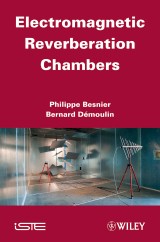Details

Electromagnetic Reverberation Chambers
1. Aufl.
|
192,99 € |
|
| Verlag: | Wiley |
| Format: | |
| Veröffentl.: | 07.02.2013 |
| ISBN/EAN: | 9781118601976 |
| Sprache: | englisch |
| Anzahl Seiten: | 432 |
DRM-geschütztes eBook, Sie benötigen z.B. Adobe Digital Editions und eine Adobe ID zum Lesen.
Beschreibungen
Dedicated to a complete presentation on all aspects of reverberation chambers, this book provides the physical principles behind these test systems in a very progressive manner. The detailed panorama of parameters governing the operation of electromagnetic reverberation chambers details various applications such as radiated immunity, emissivity, and shielding efficiency experiments.<br /> In addition, the reader is provided with the elements of electromagnetic theory and statistics required to take full advantage of the basic operational rules of reverberation chambers, including calibration procedures. Comparisons with other testing systems (TEM cells, anechoic chambers) are also discussed.
<p><b>Preface xiii</b></p> <p><b>Foreword xv</b><br /> <i>Paolo CORONA</i></p> <p><b>Introduction xix</b></p> <p><b>Chapter 1. Position of the Reverberation Chambers in Common Electromagnetic Tests 1</b></p> <p>1.1. Introduction 1</p> <p>1.2. Electromagnetic fields and plane waves 2</p> <p>1.3. Electromagnetic tests in confined areas 13</p> <p>1.4. Discussion 26</p> <p>1.5. Bibliography 28</p> <p><b>Chapter 2. Main Physical Features of Electromagnetic Cavities 29</b></p> <p>2.1. Introduction 29</p> <p>2.2. Reduction of the modes in a 1D cavity 30</p> <p>2.3. Physical features of an empty rectangular cavity 44</p> <p>2.4. The 3D cavity operating in stirred modes 69</p> <p>2.5. Discussion 77</p> <p>2.6. Bibliography 80</p> <p><b>Chapter 3. Statistical Behavior of Stirred Waves in an Oversized Cavity 83</b></p> <p>3.1. Introduction 83</p> <p>3.2. Descriptions of the ideal random electromagnetic field 84</p> <p>3.3. Simulation of the properties of an ideal random field 93</p> <p>3.4. Contribution of the statistical tests 104</p> <p>3.5. Balance of power in a reverberation chamber 121</p> <p>3.6. Discussion 130</p> <p>3.7. Bibliography 132</p> <p><b>Chapter 4. Impact of the Physical and Technological Parameters of a Reverberation Chamber 135</b></p> <p>4.1. Introduction 135</p> <p>4.2. Main parameters for reverberation chamber design 136</p> <p>4.3. The usual techniques of mode stirring 153</p> <p>4.4. The characterization of reverberation chambers 164</p> <p>4.5. Discussion 188</p> <p>4.6. Bibliography 190</p> <p><b>Chapter 5. Radiated Immunity Tests in a Reverberation Chamber 193</b></p> <p>5.1. Introduction 193</p> <p>5.2. The calibration process 194</p> <p>5.3. Examples of calibration results 206</p> <p>5.4. Implementing of the immunity test for a piece of equipment 210</p> <p>5.5. Immunity test in reverberation and anechoic chambers 220</p> <p>5.6. Rectangular components of the electric field and the total electric field 226</p> <p>5.7. Discussion 228</p> <p>5.8. Bibliography 230</p> <p><b>Chapter 6. Emissivity Tests in Reverberation Chambers 233</b></p> <p>6.1. Introduction 233</p> <p>6.2. A few notions on electromagnetic radiation and antennas 234</p> <p>6.3. Measurement of the total radiated power in free space 249</p> <p>6.4. Measurement of the unintentional emission of a device under test 252</p> <p>6.5. Measurement examples of the total radiated power 262</p> <p>6.6. Total radiated power and radiated emissivity 269</p> <p>6.7. Measurement of the efficiency and of the diversity gain of the antennas 272</p> <p>6.8. Discussion 275</p> <p>6.9. Bibliography 276</p> <p><b>Chapter 7. Measurement of the Shielding Effectiveness 279</b></p> <p>7.1. Introduction 279</p> <p>7.2. Definitions of the shielding effectiveness 280</p> <p>7.3. Measurement of the effectiveness of shielded cables and connectors in reverberation chambers 287</p> <p>7.4. Measurement of the attenuation of the shielded enclosures 302</p> <p>7.5. Measurement of the shielding effectiveness of the materials 307</p> <p>7.6. Discussion 316</p> <p>7.7. Bibliography 318</p> <p><b>Chapter 8. Mode Stirring Reverberation Chamber: A Research Tool 321</b></p> <p>8.1. Introduction 321</p> <p>8.2. A non-ideal random electromagnetic field 324</p> <p>8.3. Studying the correlation of a set of measurements 336</p> <p>8.4. Quantization of the scattered and coherent fields in a reverberation chamber 349</p> <p>8.5. Discussion 356</p> <p>8.6. Bibliography 358</p> <p><b>APPENDICES 361</b></p> <p><b>Appendix 1. Notion of Probability 363</b></p> <p>A1.1. The random variable concept 363</p> <p>A1.2. Probability concept from intuition 363</p> <p>A1.3. Probability density function (pdf) 364</p> <p>A1.4. Computation of moments 365</p> <p>A1.5. Centered and normalized variables 366</p> <p>A1.6. Computation of the variance and standard deviation 367</p> <p>A1.7. Probability distributions 367</p> <p>A1.8. The cumulative distribution function (cdf) 369</p> <p>A1.9. The ergodism notion 369</p> <p>A1.10. Features of the random stationary variables 372</p> <p>A1.11. The characteristic function 373</p> <p>A1.12. Summary of the main probability distributions 375</p> <p>A1.13. Tables of numerical values of the normal distribution integrals 378</p> <p>A1.14. Bibliography 379</p> <p><b>Appendix 2. Formulas of the Quality Factor of a Rectangular Cavity 381</b></p> <p>A2.1. Quality factor of the TMm n p mode 381</p> <p>A2.2. Calculation of the average Q quality factor 382<br /> <br /> A2.3. Bibliography 384</p> <p><b>Appendix 3. Total Field and Total Power Variables 385</b></p> <p>A3.1. Total field variables 385</p> <p>A3.2. χ2 variable attached to the total field 386</p> <p>A3.3. Total field probability density function 386</p> <p>A3.4. Calculation of the mean of the total field 387</p> <p>A3.5. The pdf of the total power 388</p> <p>A3.6. Calculation of the mean total powers 389</p> <p><b>Appendix 4. Calculation of the Variances of υφ, υη, υθ 391</b></p> <p>A4.1. Variance of the υφ and υη variables 391</p> <p>A4.2. Variance of the υθ variable 392</p> <p><b>Appendix 5. Electric Dipole Formulas 395</b></p> <p>A5.1. Complete formulas of the electric dipole 395</p> <p>A5.2. Near-field formulas of the electric dipole 397</p> <p>A5.3. Far-field formulas of the electric dipole 397</p> <p>A5.4. Bibliography 398</p> <p>Index 399</p>
"The book is recommended both as a reference for researchers and professionals working with reverberation chambers, and as a textbook for a course on reverberation chambers." (Radio Science Bulletin, 1 December 2011) <p> </p>
<p><strong>Bernard Démoulin</strong> is a professor at the Institute of Electronics, Micro, and Nanotechnologies (IEMN) in Lille, France. <p><strong>Philippe Besnier</strong> is a researcher at the National Center for Scientific Research (CNRS) in France.


















